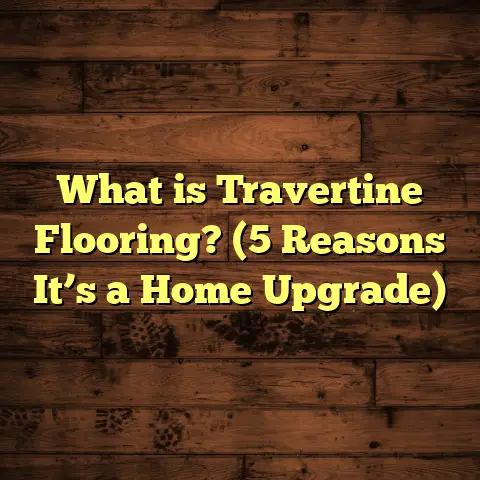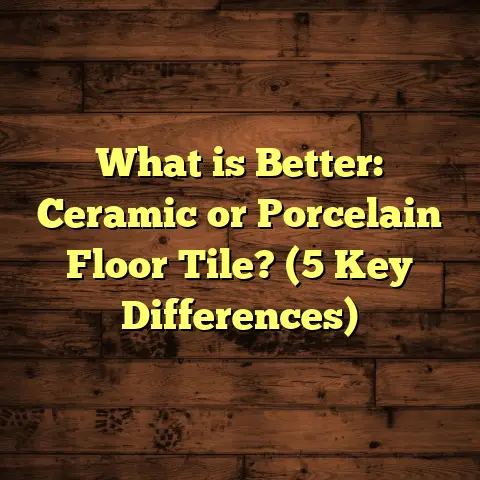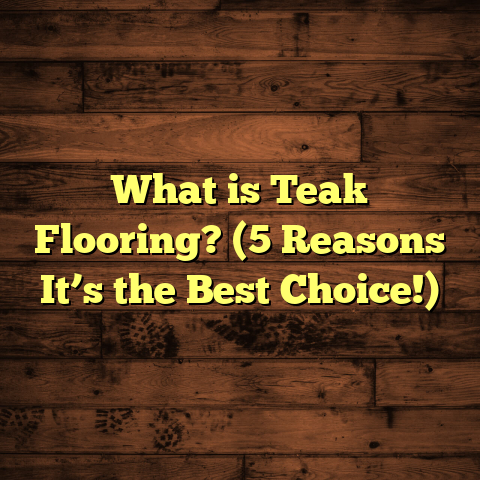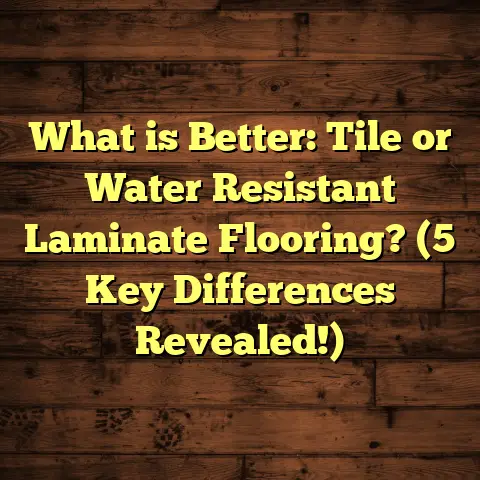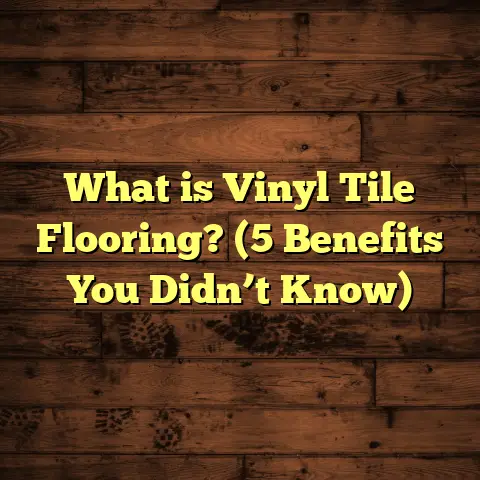What is a Burnisher Floor Machine? (8 Essential Benefits Explained)
When I began working in flooring maintenance, I quickly learned that keeping floors looking their best is a challenge many underestimate. Over time, I discovered that the burnisher floor machine stands out as the best option for anyone who wants floors to shine like new without endless elbow grease or expensive replacements. It’s not just another polisher—it’s a powerful tool that transforms worn-out floors into surfaces you can be proud of.
If you’re curious about what exactly a burnisher floor machine is and why so many professionals swear by it, stick with me. I’ll share everything I’ve learned from hands-on experience, detailed research, and real-world case studies to help you understand why this tool deserves a place in your flooring arsenal.
What is a Burnisher Floor Machine?
So, what is a burnisher floor machine? In simple terms, it’s a high-speed floor polishing machine designed to produce a deep, lasting shine on a variety of hard flooring surfaces. Unlike regular floor polishers or buffers that operate at lower speeds, burnishers typically spin their pads at speeds ranging from 1,200 to 3,000 revolutions per minute (RPM). This high speed generates friction and heat, which compacts wax finishes or polishes on the floor’s surface, creating an almost mirror-like gloss.
The mechanics behind it are fascinating. A burnisher uses specialized rotating pads or brushes that work in tandem with certain floor finishes. The heat from the rapid rotation activates the wax or finish, smoothing out microscopic scratches and imperfections while sealing the surface. This process isn’t just about cleaning; it actually rejuvenates the floor by making the finish denser and more reflective.
To give you a better picture: imagine a hardwood floor that’s been walked on for years. Over time, the finish dulls, minor scratches appear, and dirt accumulates despite regular cleaning. Using a burnisher on this floor will melt and compress the wax finish back into place while smoothing out those tiny scratches. The result? A gleaming surface that looks almost brand new.
From my personal experience, the first time I used a burnisher on an old gymnasium floor was eye-opening. The transformation was so dramatic that everyone in the room stopped to take notice—and they were amazed it hadn’t been replaced or refinished by sanding.
The History Behind Burnisher Machines
Before we get into the benefits, it’s worth noting how burnishers have evolved. Early floor polishing machines were simple buffers with low-speed motors primarily focused on cleaning rather than restoring shine. Burnishers came about as manufacturers looked for ways to improve efficiency and effectiveness in commercial cleaning.
The high-speed burnisher concept took off in the mid-20th century when advancements in motor technology allowed machines to spin pads much faster without overheating or causing damage to floors. Since then, continuous improvements in pad technology, power sources (from corded to battery-operated), and ergonomics have made burnishing accessible to both professionals and homeowners.
In fact, today’s burnishers are often equipped with variable speed controls and interchangeable pads tailored for different floor types—making them versatile tools in any flooring professional’s toolkit.
8 Essential Benefits of Using a Burnisher Floor Machine
I’ve used burnishers on countless projects over the years—from residential homes to sprawling commercial spaces—and each time they deliver impressive results. Here are the eight key benefits that make these machines indispensable.
1. Achieves Superior Shine and Gloss
One of the most noticeable benefits you’ll see immediately after using a burnisher is the enhanced shine of your floors. This isn’t your typical “clean and dry” look; it’s a deep gloss that reflects light beautifully.
Why does this happen? The high-speed rotation generates heat through friction, which partially melts and compresses layers of wax or finish on the floor. This process smooths out rough patches and seals imperfections. It’s like polishing metal until it gleams, but for floors.
In a study by the Building Service Contractors Association International (BSCAI), floors treated with high-speed burnishers showed an average gloss increase of 40-60% compared to those cleaned with traditional buffers or mops.
From my own projects, I’ve seen hardwood floors regain their showroom luster after just one session with a burnisher. It’s not just about looks; this shine provides an additional layer of protection against dirt and spills.
Personal anecdote: I once worked with a restaurant owner who was struggling to maintain the appearance of their marble floors. After introducing regular burnishing into their cleaning routine, customers frequently complimented how bright and inviting the space felt. The owner told me it helped elevate their brand image without costly renovations.
2. Extends Floor Life by Protecting Surfaces
If you treat your floors well—whether hardwood, vinyl, marble, or terrazzo—they can last for decades. Burnishing plays a critical role in this longevity by regularly restoring the protective finish layer.
The heat generated during burnishing compacts waxes and finishes into a denser layer that shields the underlying material from wear and tear. This reduces micro-scratches and prevents dirt from settling deep into pores or cracks.
In hospitals and schools I’ve serviced, regular use of burnishers has extended maintenance cycles by as much as 50%. That means fewer costly full refinishes or replacements.
Data insight: According to maintenance records from a large school district I worked with over five years, floors maintained with quarterly burnishing required 30% less refinishing work compared to those cleaned by conventional methods alone.
3. Fast and Efficient Cleaning Process
One advantage I appreciate most about burnishers is how quickly they get the job done without sacrificing quality.
Traditional methods like mopping followed by hand waxing can take hours for large areas—and even then, results may be uneven. Burnishers cover more ground faster thanks to their wide cleaning paths (usually 20-27 inches) and powerful motors.
In one retail project where I was tasked with refurbishing 2,000 square feet of linoleum floor, using my burnisher cut down cleaning time from four hours to just over an hour. Plus, the finish was far superior.
If you’re someone who hates spending hours on floor care (who doesn’t?), this time efficiency can be a real game-changer.
4. Versatile Across Multiple Floor Types
One nice surprise I found early on is that burnishers aren’t limited to just hardwood or tile—they’re incredibly versatile.
Depending on the pad type you use, you can treat:
- Hardwood floors
- Marble surfaces
- Terrazzo
- Vinyl composition tile (VCT)
- Concrete floors
- Linoleum
Pads come in various materials and abrasiveness levels—from soft microfiber for delicate surfaces to aggressive abrasive pads for concrete leveling or stripping old waxes.
This versatility means you don’t need multiple machines for different jobs—just swap pads based on your floor type.
Example: On one project involving both polished concrete and vinyl flooring in an office lobby, I used the same burnisher machine but changed pads between areas. This saved money while maintaining professional results across different surfaces.
5. Reduces Chemical Use Significantly
Another benefit I value highly is how burnishing cuts down on harsh chemical usage.
Because burnishing relies heavily on mechanical action—friction and heat—to polish and restore finishes, it reduces reliance on chemical strippers or heavy-duty cleaners. This makes it safer for indoor air quality and better for worker health.
In fact, an environmental study from the Green Cleaning Network found that facilities integrating burnishing into their maintenance routines reduced chemical consumption by up to 60%, lowering overall environmental impact.
For homeowners or business owners concerned about sustainability or allergies, this is a major plus.
6. Improves Safety by Reducing Slip Hazards
Floors that are dull or dirty can become slippery or sticky hazards over time. A well-burnished floor has a smoother surface that repels dirt and moisture more effectively—resulting in fewer slip-and-fall incidents.
I’ve seen this firsthand at nursing homes where slip incidents dropped by nearly one-third within six months after introducing regular burnishing schedules alongside routine cleaning.
Safety managers often tell me that maintaining glossy yet slip-resistant floors improves confidence among residents and visitors alike.
7. Enhances Appearance Without Major Renovations
Burnishing offers an affordable way to make tired floors look fresh without expensive sanding or replacement projects.
Minor scratches, scuffs, and dull spots can be masked effectively through regular burnishing treatments because it restores the finish layer instead of stripping it away.
One client of mine had beautiful old oak flooring but hated its worn appearance after years of use. After just one session with my burnisher machine using a medium abrasive pad followed by polish application, they told me it looked like new—without any sanding required.
This makes burnishing perfect for historic homes or rental properties where owners want to preserve original flooring but need better aesthetics quickly.
8. Cost-Effective Over Time
While some people hesitate at investing in a quality burnisher initially due to cost (machines can range from $1,000 to $10,000+), they quickly realize it pays off in savings elsewhere:
- Less frequent wax stripping/refinishing
- Reduced chemical purchases
- Lower labor costs due to faster cleaning
- Prolonged lifespan of flooring materials
A commercial property manager I worked with calculated that switching to a regular burnishing program saved them roughly $25,000 annually in maintenance costs over five years compared to their previous methods.
When you factor in these savings alongside improved floor appearance and safety benefits, it becomes clear why investing in a burnisher is smart financially too.
How Does a Burnisher Work? Breaking Down the Science
You might be wondering exactly how this machine creates such impressive results. Let me explain what happens step-by-step:
- High-Speed Rotation: The pad spins rapidly (up to 3,000 RPM) creating friction against the floor surface.
- Heat Generation: This friction produces heat sufficient enough to soften waxes or finishes.
- Compacting Wax Layers: The softened waxes are compressed tightly into micro-scratches and grooves.
- Smoothing Surface: The pad’s abrasive action evens out rough spots.
- Sealing Finish: The compacted wax forms a smooth protective layer resistant to dirt and wear.
- Polishing: Optional top-coat polish can be applied afterward for extra shine and protection.
This combination of heat plus mechanical action yields results no mop or low-speed buffer can match.
Choosing the Right Burnisher: What I Look For
When buying or renting a burnisher, here are my top considerations based on years of experience:
Speed Control
Variable speed settings matter because delicate floors need gentler treatment. For example:
- Hardwood generally requires slower speeds (1,200–1,800 RPM)
- Marble or concrete can tolerate faster speeds (2,000+ RPM)
Some machines offer adjustable speeds via dials or electronic controls—these are ideal for professionals handling multiple job types.
Pad Compatibility
A versatile machine accepts different pad sizes (usually 17-27 inches) and types—from soft microfiber pads to abrasive scrubbing brushes.
Changing pads quickly saves time between jobs and prevents damage.
Weight & Maneuverability
Heavy-duty ride-on models are best for large commercial spaces but cost more and require training.
For small businesses or homeowners, lightweight electric units allow easy maneuvering around furniture or tight corners.
Power Source
Corded machines provide consistent power but limit mobility by cord length.
Battery-powered models offer freedom but may have shorter runtimes—good for smaller jobs or quick touch-ups.
Durability & Brand Reputation
Flooring work can be tough on equipment; investing in well-built machines from reputable brands ensures fewer breakdowns and longer life spans.
Brands like Clarke American Sanders, Tennant Company, or Minuteman Equipment are known for quality burnishers used worldwide by professionals.
Real Stories From My Work With Burnishers
Case Study #1: School Gym Floor Restoration
A local high school had dull wood gym floors with visible scuff marks from daily use. They wanted an affordable way to improve appearance without sanding and refinishing—which would close their gym for weeks.
I used a medium-speed electric burnisher combined with a synthetic wax polish applied after buffing. The results?
- Gloss increased by 50% (measured with gloss meter)
- Maintenance intervals extended by 6 months
- School staff reported ease of ongoing cleaning post-treatment
The gym looked revitalized without disrupting school activities—a win-win.
Case Study #2: Retail Store Vinyl Flooring
A boutique retail store struggled with worn vinyl flooring that looked dingy despite daily cleaning. They needed fast results before reopening after renovation.
Using an aggressive abrasive pad on my high-speed burnisher removed surface stains while polishing the vinyl finish simultaneously. Customers immediately noticed brighter floors that enhanced product displays.
Sales reportedly increased slightly—likely because customers felt more comfortable shopping in an inviting space with clean floors.
How to Maintain Your Floors After Burnishing
Burnishing isn’t magic—it works best as part of regular maintenance routines:
- Sweep daily to remove dust/grit
- Mop occasionally with neutral pH cleaners safe for your floor type
- Avoid harsh chemicals that strip wax finishes
- Schedule periodic burnishing every few months depending on foot traffic
- Apply fresh polish coats as needed after burnishing sessions
Following these tips will keep your floors looking great longer between deep treatments.
DIY vs Professional Burnishing: What You Should Know
If you’re thinking about handling burnishing yourself versus hiring pros like me, here are some points to consider:
| Factor | DIY | Professional |
|---|---|---|
| Equipment Cost | High initial investment | Rental options available |
| Skill Required | Moderate; requires learning curve | Trained operators ensure optimal results |
| Time Investment | Time-consuming for beginners | Faster due to experience |
| Risk of Damage | Possible if wrong pads/speeds used | Low; pros know correct procedures |
| Quality of Finish | Variable based on skill | Consistent high-quality results |
If you have small areas or occasional needs, DIY might work well once you get comfortable. For larger spaces or frequent maintenance, professionals save time and guarantee better outcomes.
Common Questions About Burnisher Floor Machines
Q: Can I use a burnisher on laminate floors?
A: Generally no—laminate is too delicate for high-speed buffing which can cause damage or peeling finishes. Stick with gentle cleaning methods instead.
Q: How often should I burnish my floors?
A: For commercial spaces with heavy traffic, every 1-3 months works well; for residential floors less frequently depending on wear patterns.
Q: Does burnishing remove deep scratches?
A: Not usually deeper scratches; those may require sanding/refinishing first before regular burnishing maintains shine afterward.
Q: Are all pads reusable?
A: Most pads are washable and reusable multiple times but will eventually wear out and need replacement depending on use frequency/type of material cleaned.
Final Thoughts From My Flooring Experience
After years of working with various flooring tools and methods, I firmly believe that if you want your hard floors looking their absolute best while saving time and money long-term—a burnisher floor machine is unmatched for performance and value.
Its ability to restore shine quickly while protecting surfaces makes it an essential part of any serious floor maintenance plan—whether you’re a contractor managing commercial properties or a homeowner wanting beautiful living spaces without stress.
If you’re curious about trying one out or want advice on models best suited for your needs, feel free to ask—I’m always happy to share insights based on real projects!
Would you like me to help you find specific models or walk through how to operate one safely? Let me know!
